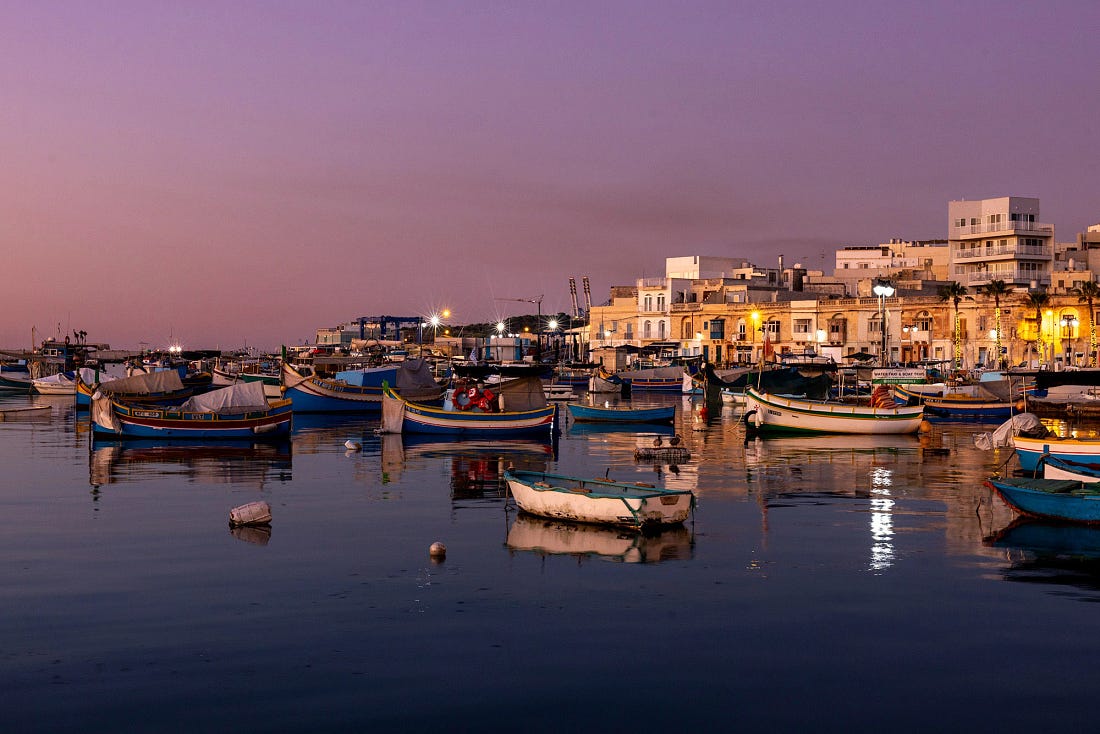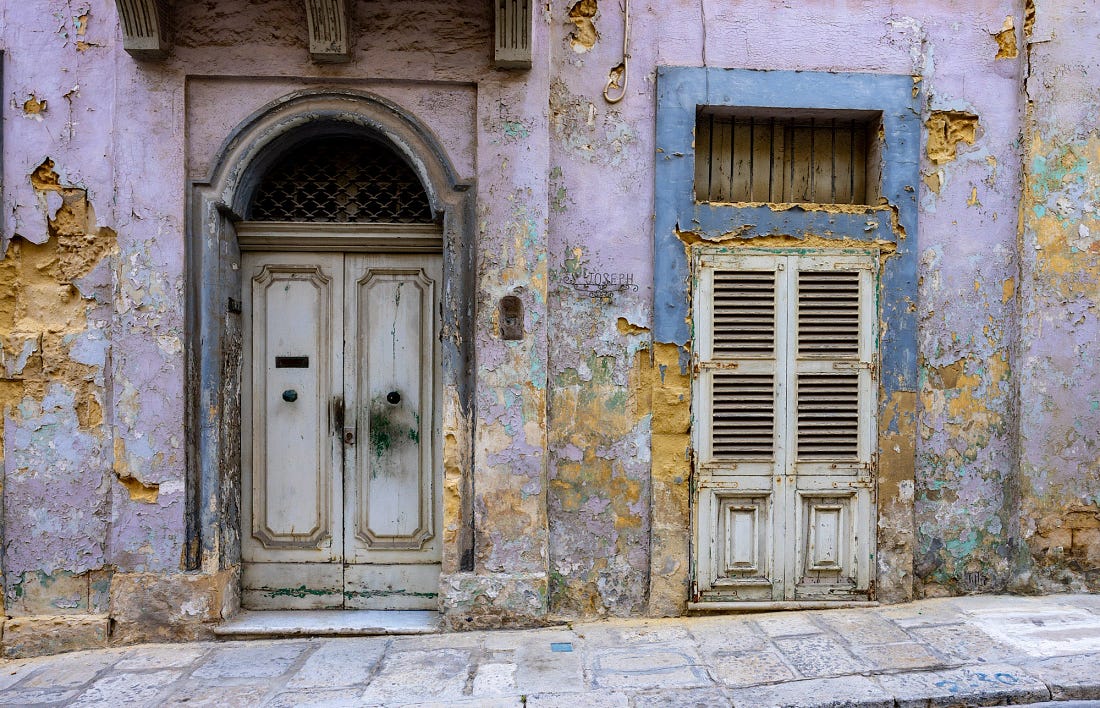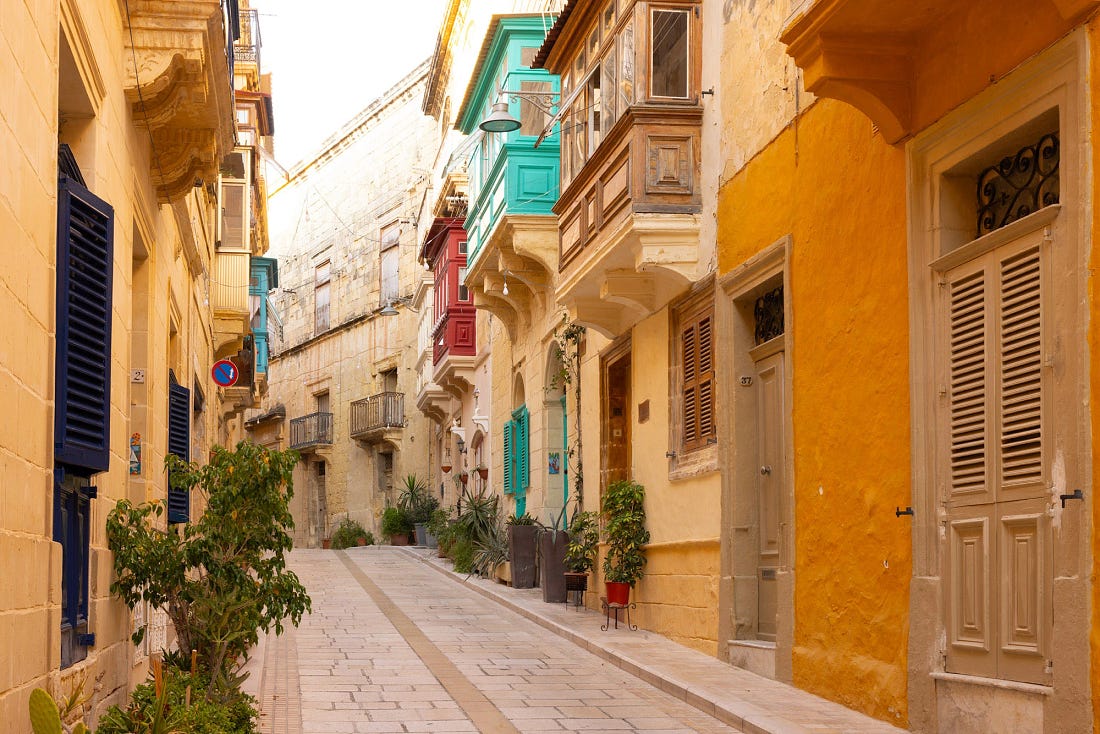Part II: Following the Trail of Ġbejna Across MaltaFrom Neolithic seafarers to modern refugees, the hidden history of Malta is written in cheese.You can read this article with high resolution photography at Notes from the Road. This page also includes Part I. MarsaxlokkIt’s an hour before sunrise, and I’ve arrived in the fishing village of Marsaxxlokk to watch the fishermen head out to sea. Some Maltese fishermen still leave Marsaxxlokk Bay in double-ended hull, brightly painted fishing boats, known as Luzzo. Luzzo boats have prows that are painted with the Eye of Osiris, a symbol of protection and bounty at sea. They tell a story; the next chapter of cheese in Malta. Marsaxxlokk’s namesake bay has served the island as a protected harbor since the Neolithic age. In prehistory, the boats in the bay were likely simple dugout canoes, reed boats. There may have even been simple plank boats, stitched together with fiber and leather. But something was amiss in Malta. By 2,500 BCE, the neolithic civilization that built Mnajdra and Ħaġar Qim no longer existed. They overfarmed, overgrazed, and deforested Malta and Gozo, leaving the Maltese islands bare and desertifying them as much as the Sicily they escaped from three thousand years before. Their once-advanced society slowly unraveled under the weight of its own environmental collapse. While the civilization perished, scattered Maltese hung on. They fled to the highest elevations, places where crops could still thrive, and where they could build camouflage settlements, complete with defensive walls and moats. As maritime technology began to improve across the Mediterranean, so did the opportunities for raiders and pirates to pillage quiet, distant islands, emptying coastal villages. In the 8th century BCE, Phoenician ships began to visit Marsaxlokk Bay regularly. These ships were technological marvels of their age: double-ended hulls built for speed, balance, and longevity, with high prows painted with protective eyes to watch over the voyage. Their design was so sound and seaworthy, that Malta has carried the design forward for three thousand years. The luzzu boats I see this morning, with their rounded, double-ended hulls, their bold bands of orange, red, blue, yellow, and green, and the watchful eyes painted on their bows are twentieth-century descendants of those Phoenician craft. The Phoenicians arrived as merchants in ships carrying Levantine timber, murex dye, salted fish, amphorae of wine, and…livestock. To them, Malta was a strategic stopover for trade further west. But it was so essential to them that many of them stayed. Malta’s language, customs, and religions eventually folded, overlapped, and mingled with all things Phoenician. From the Levant, these traders brought new hardy breeds of goat and sheep, animals that had been bred to thrive on rocky uplands. They were also prized for their rich milk. In Malta, where rain was scarce and pastures thin, these goats and sheep thrived. They interbred with Malta’s local stock, producing flocks that gave more milk and milk of a quality better suited to curdling and storage. For the Phoenicians, dairying was as important as the milk itself. They had perfected techniques of preserving milk into food that would endure. They were experts at creating salted cheeses, among which they used to help sustain their sailors on long sea voyages. We know this rom clay strainers and amphorae found in Phoenician settlements from Tyre to Cádiz. The Phoenician cheesemaking skills would have pervaded Malta. From the newly arrived immigrants, the Maltese would have learned to curdle milk in woven rush baskets, pressing cheese wheels to harden in the sun, and salting curds to last through summer droughts. Already sweating, I sit on a bench, glugging my ice water, watching two alley cats playing beneath a drydocked luzzo. I nearly miss a fisherman slipping into his skiff. “They are good cats,” he says as he paddles out toward the luzzo he says was passed down from his grandfather. While he works along its hull, I ask about the colors. He points to the thin line on the bow. “This is the mustache. All luzzo have the mustache. It is part of the face.” The red and yellow, he explains, tell other fisherman that it’s from Marsaxlokk; another boat farther out, he can tell at a glance, is from St. Paul’s Bay. I can imagine this man’s grandfather setting out from this same bay 60 years ago. I imagine Montclair writing about this place in his imaginary notebook, Cheese Travel in the Central Mediterranean. Maybe this scene would make him quip about the fashionable recipes of Paris, which he didn’t disrespect, but saw as something fleeting. Of that year’s favorite recipes, Oeufs à la Chimay or Crêpes Suzette flambées, he might have said: “The dish of the day parades its novelty, but the elemental foods do not change their character. Bread, oil, vinegar, wine, and cheese evolve with their makers each year, with each region stamping them with its climate and custom, making them the most complete mirrors of a place and its long history.” Today, the world celebrates about 4,000 types of cheese. But when Montclair was traveling through Europe in the 1920s, cheeses were being forgotten, or even on the verge of being lost forever. To many in the 1920s, cheese had consolidated to the “best”, and most exportable: Cheeses like Roquefort, Cheddar, Manchego, Parmigiano Reggiano. But the specialty cheeses that are now considered among the most lovely, unusual and spectacular were almost lost in a century of hyper-industrialization, war and communist collectivism. Ġbejna does not share the relative global fame of cheeses like Appenzeller or Mimolette or even Époisses de Bourgogne; even though it is beloved in Malta, it is a hyper-local cheese almost unknown anywhere else. But those semi-famous cheeses were almost lost too. His acquaintances, although not his clients, would have been frustrated with him at times for his interest in unknown cheeses. “If you want to travel for cheese, you stay in France!” they might have said. But there were real world Montclair’s — food and travel writers who understand that the hyperlocal cheeses found in the most faraway corners of Europe weren’t backward relics of the last century, but intrinsic cornerstones of gastronomy. It was often these writers, paired with a handful of local farmers, whose dual passion led to keeping most of those 4,000 cheeses alive in an age that wanted them to be forgotten forever. They were the string that held them up until governments and slow food movements intervened. Salina BayConstantino, a rideshare driver, picks me up hours before predawn. He usually starts his work day around 3:30 AM, but, “I slept in an hour. It was a late night last night.” Partying, I ask? “No, no. Miss Universe Pageant.” ”Really?” I ask. “It’s my daughter. She has been in pageants her whole life. She wanted to see this. She is competing for the regionals in Żebbuġ. There she won number six for most photogenic, number three for best personality and number four for beauty with a purpose!” I am impressed by a dad’s dedication to his child’s hobby, but then our conversation turns to his honeymoon. “Two weeks in United States! We saw all the studios! Dynamite Nights Stunt Spectacular was our favorite.” “What was that?” I ask. “Miami Vice! They are on jet skis and explosions everywhere!” Having spent a third of my life in Los Angeles, I recognize the showbiz parenting in this, and wonder if this is truly their daughter’s passion. Stage lights are poor substitutes for sunlight in a young life, and no ribbon or sash makes up for the loss of carefree youth. When we arrive at a pullout in a roundabout, Salina Bay Nature Reserve, on Malta’s northern coast, Constantino looks out the window for a moment. “I have lived on Malta my whole life. I have never been to this place.” He says, referring to the reserve, and with his arm over the wheel, a dumbfounded expression on his face. Salina Bay is a large and narrow inlet that funnels into a series of salt pans. At the tip of the funnel, its edges are stitched with low stone walls and rectangles of shallow water. The Phoenicians were the first to see what the bay could offer. They coaxed salt from the tide with rough channels and shallow basins, letting the sun and wind finish the work. Salt was wealth in a form that could be loaded by the sack, carried in a single hold across half the Mediterranean. But the Phoenicians thought like traders, not industrialists. It was the Romans who, after conquering the Carthaginians (who were themselves inheritors of the Phoenician trade routes) in 218 BCE, turned Salina from a local mine into a machine. They squared the saltpans, deepened the channels, and reshaped the shoreline. The long, low warehouses they built could shelter mountains of salt from rain and spray, ready shipment to Sicily, Ostia, or Carthage. Under Rome, Maltese salt was counted, taxed, and moved by market forces as predictable as the tides. Most of it went away for export. But some of it stayed. The Romans understood better than the island’s earlier residents that salt could change the life of milk, stretching it from days into weeks. Salt from Salina made its way to the farms of Malta and Gozo, making it possible for dairy farmers to dry and store simple cheeses, as well as to prepare curds that could survive a long journey over rough roads or across the channel to Sicily. The salt pans are dead quiet at dawn, and they catch the reflection of modern, run-down apartment buildings in the distance. Out beyond the low walls, dozens of fiberglass boats are anchored everywhere. Salina, once industrial, is now a nature reserve, its brine flats are protected for the birds that cross here on migration. It’s summer, and in summer Salina is the only reserve that remains open. The nearby estuaries, the only others in Malta, are closed because they simply dry up and are nearly devoid of any life at all. Without rivers, summer has nothing to offer the hundreds of species that migrate back and forth between Europe and Africa. I find a man staring out with a telephoto lens at the mostly empty salt flats from a blind. I sit down next to him and ask him if there is anything interesting out there. Mario has been a volunteer with BirdLife Malta since the 1970s. He began banding birds in 1976, the year the salt pans were still an industrial place. Lately, he explains, he’s been spending a lot of time banding Common Swifts. “When you band them, you have to lock this tiny oval ring around their leg. So you have them on your hand, but their legs lock on you.” He shows me the scratches, nicks and cuts on his hand. “To get them off, you have to thrust up like this.” He jolts his arm upwards. Today, he is scanning the small population of Yellow-legged Gulls on the flats, watching for the flash of metal rings on a leg. In Europe and North Africa, color bands attached to gull legs create field-readable IDs. The “code” is made up of the color, position, and any alphanumeric characters on the ring, read top to bottom, left leg to right leg. A red band doesn’t universally mean one thing, as colors are assigned by individual ringing projects, all registered in the European Colour-Ring Birding database. For example, Belgian gulls may carry large white or yellow rings with black letters, Mediterranean projects often use red rings with white codes, and Nordic codes frequently use blue rings with white lettering. The important part is not the color itself but the unique combination of color, lettering, and placement, which identifies the bird’s origin and history. Mario shows me his laminated cheat sheet which shares different codes of different gulls. Some were born in Croatia, Slovenia, Hungary, the Netherlands, Norway, Denmark, Poland and Russia. When he spots a new gull band, he can contact the bander from the bird’s country of origin and ask about its life history. From these replies, he learns how far the bird has traveled, how old it is, and its route across seas and seasons. The gulls rest here on their way to somewhere else, as they did when Phoenician traders landed here. They rest here just as the Romans, Arabs, and Sicilians came and went. The routes change, but the pattern holds: arrivals, departures: lives linked by this island and the salt water around it. People are not banding birds for the fun of it. Much of it has to do with learning how bird populations are changing alongside our changing climate. Often, it means birds are shifting their populations northwards. I was the first to see and report a Pearly-eyed Thrasher in the northern Bahamas, the northernmost record. An individual sighting is one thing, but consistent data is another. Citizen sightings, bands, and GPS trackers together help tell a statistically relevant story. Sitting here with him, the salt pans feel less like the ruin of a forgotten industry and more like a ledger of crossings. Each banded bird is part of a record, each migration a footnote in a long history of comings and goings that have shaped Malta. It was actually the Northern Bahamas where I started thinking about this intersection between climate and immigration. In 2019, Hurricane Dorian struck the Abaco Islands with sustained winds of 185 mph and surges over 20 feet. It was the strongest hurricane ever to hit the Bahamas. The Abacos, where I spent part of my childhood, were devastated. Nearly every building in Marsh Harbour was damaged, and entire Haitian migrant communities like The Mudd and Pigeon Peas were flattened. The true death toll will never be known, but some quietly estimate thousands. The storm was a reminder that climate kills immigrants first, and that immigration politics are universal: when societies take the wrong approach, everyone loses. Just days later, the Miami Herald highlighted Craig Roberts, developer of Bahama Beach Club, who built a hurricane-proof church as a shelter for his undocumented Haitian workforce. He understood that protecting them was essential to the island’s economy. At the same time, the Washington Post reported on Bakers Bay Golf & Ocean Club, a luxury enclave that evacuated its ultra-wealthy homeowners while leaving hundreds of Haitian workers in flimsy, flood-prone settlements. Between 300 and 800 Haitians, most employed directly or indirectly by Bakers Bay, died in Marsh Harbour. The contrast is stark: Roberts chose moral responsibility; Bakers Bay did not. And as in so many places, blame is tangled—immigrants crossing illegally, developers exploiting their labor, locals refusing the work yet denying them legal paths. The cycle leaves the most vulnerable in an exploitative state. Here in Malta, thinking about that Pearly-eyed Thrasher and those guys I knew my whole life, but who I never saw again after 2019, I understand that it is all part of the same story. There’s immigration enforcement here in Europe that works. You see it in the patrol boats, processing centers, and the machinery of borders. And there’s the other kind too: the ugly, feverish version, feeding on slogans and suspicion, turning strangers into enemies before they’ve even stepped onto the quay. It’s easy to get pulled into arguing the merits of policy and the limits of law, and there is truth in the idea that a country can, and should, guard its borders. But even sound immigration policy is a wall built on shifting sand. The bigger story isn’t just about the people from Africa or the Middle East making dangerous crossings to reach Europe. The bigger story is that the climate itself is moving the map lines. The same heat, drought, and failed harvests that are driving farmers from the Sahel will also move Italians, Spaniards, Greeks, and Maltese northward when their own land and water give out. The real immigration debate isn’t about border patrols or asylum quotas, but about climate policy. Malta’s whole story is a tide of arrivals. The island has been Phoenician and Punic, Roman and Byzantine, Arab and Norman, Aragonese and French, British and Maltese. Malta is a porous membrane; each wave left something behind. Malta’s strength is not its purity; but its layers of diverse culture. In that way, It’s not so different from where I live, the place I call the Far West: California, Oregon, Washington, and Hawaii. I have hypothesized for a long time that the beginnings of an answer to the intersection of climate and immigration can be hinted at out here. Taken together, these four states make the world’s third-largest economy. As an entity, this region edges out Japan and Germany. There are many reasons for this region’s enormous and unparalleled economic success: good soil, tech, entertainment, and ports. But there is something else unique to the American Far West that glues all these other things together: the Far West is the most diverse place on Earth. More languages are spoken here than anywhere else. More religions are practiced here — also, more lack of religious affiliation. It thrives on multidimensional diversity. And more than ethnicity: age, origin, gender, religion, and the intermingling of people from rural and urban communities. It is an imperfect but undeniably dynamic mix that fuels innovation, resilience, and global reach. This richness is deepened by a porous membrane of undocumented immigration, which adds new energy, skills, and perspectives to the region’s economy and culture. And in my region, the contribution of undocumented immigrants is not just cultural; it’s structural. They harvest crops, build homes, clean hotels, cook in restaurants, care for children and elders. They hold up whole sectors of the economy. We are strong not in spite of them, but because of them — that porous membrane of the Far West is its unifying strength. Diversity in all forms equals tolerance, innovation, creativity, and work ethic. The Far West has shown what works: openness paired with smart governance, diversity as an economic engine, tolerance as a civic value. In California, Oregon, Washington, and Hawaii, people from everywhere work side by side, documented or not. What I see in the United States under the second Trump administration is a politics of punishment. Mass deportation budgets swell to $170 billion; FEMA staff are pulled from disaster response to serve ICE; citizens are detained for their surnames; birthright citizenship is attacked. Military bases turn into detention camps, humanitarian parole is ended for hundreds of thousands, and raids sweep farms and towns more to terrify than to solve. Cruel, and definitively flawed. A policy that treats migration as a crime to be crushed instead of a reality to be managed is going to collapse under its own weight, even as it scars people and economies in its collapse. It ignores the climate pressures building in the global south and the Mediterranean. It ignores the droughts and floods that move millions whether politicians like it or not. Here again, the Far West shows another path. California and Washington lead the world with aggressive emissions targets and renewable mandates. Oregon and Hawaii push forward with solar, wind, hydro, and geothermal projects and industries. Cities invest in wildfire resilience and water conservation. Universities and tech companies pioneer climate science and clean-tech breakthroughs. Europe can follow this model, where immigration is integrated with economic planning and social investment, or it can mimic the MAGA regions of the U.S., where fear and cruelty rule. One path follows climate science and compassion; the other is what America suffers now: policy not only unjust and uninformed, but destined to fail. Climate change will make the tide literal and figurative. Rising seas, failed harvests, and unbearable summers will push people across the Mediterranean and across Europe. It won’t just be the farmers from Sudan, but families from Sicily, Andalusia, even from Malta itself, all moving north in search of livable ground. The real immigration debate here, and everywhere, isn’t about stopping movement; it’s about preparing for it. Malta’s past shows that movement can be strength if it’s met with planning, compassion, science, and a place for everyone at the table. But for all their ships and salt, neither the Phoenicians nor the Romans had the craft to make Malta’s most enduring food. That distinction would come later, from a culture that thrived as a porous membrane itself, drawing knowledge from India, Greece, and Spain, weaving science, agriculture, and taste into something new. Out of that long current of exchange, Malta’s Ġbejna cheese would finally take shape. Section 3 of 3 will be published on my Substack in two weeks. Notes from the Road is free today. But if you enjoyed this post, you can tell Notes from the Road that their writing is valuable by pledging a future subscription. You won't be charged unless they enable payments. |






